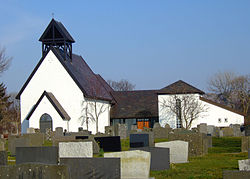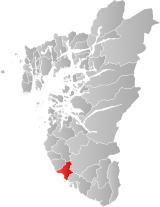Ogna (municipality)
Ogna Municipality
Ogna herred | |
|---|---|
| Ogne herred (historic name) | |
 View of the local Ogna Church | |
 Rogaland within Norway | |
 Ogna within Rogaland | |
| Coordinates: 58°30′56″N 05°48′29″E / 58.51556°N 5.80806°E | |
| Country | Norway |
| County | Rogaland |
| District | Jæren |
| Established | 1839 |
| • Preceded by | Eigersund Municipality |
| Disestablished | 1 Jan 1964 |
| • Succeeded by | Hå Municipality |
| Administrative centre | Ogna |
| Area (upon dissolution) | |
| • Total | 104 km2 (40 sq mi) |
| Population (1964) | |
| • Total | 1,470 |
| • Density | 14/km2 (37/sq mi) |
| Demonym | Ognabu[1] |
| Time zone | UTC+01:00 (CET) |
| • Summer (DST) | UTC+02:00 (CEST) |
| ISO 3166 code | NO-1117[2] |
Ogna is a former municipality in Rogaland county, Norway. The 104-square-kilometre (40 sq mi) municipality existed from 1839 until its dissolution in 1964. The municipality encompassed roughly the southern third of the present-day municipality of Hå. The administrative centre of the municipality was the village of Ogna where the Ogna Church is located.[3][4]
History
[edit]The municipality of Ogna was established in 1839 when it was split off from the (much larger) municipality of Egersund landdistrikt, the rural municipality surrounding the town of Egersund. Initially, there were 825 residents of Ogna. During the 1960s, there were many major municipal changes across Norway due to the work of the Schei Committee. On 1 January 1964, the three neighboring municipalities of Nærbø, Varhaug, and Ogna were all merged into one large municipality called Hå. Prior to the merger, Ogna municipality had 1,470 residents.[5]
Name
[edit]The municipality (originally the parish) is named after the old Ogna farm (Old Norse: Ógna) since the first Ogna Church was built there. The name comes from the verb ógna which means "to threaten", likly referring to the local river since it has strong currents and it is prone to flooding in the spring.[6] Historically, the name of the municipality was spelled Ogne. On 3 November 1917, a royal resolution changed the spelling of the name of the municipality to Ogna.[7]
Government
[edit]While it existed, this municipality was responsible for primary education (through 10th grade), outpatient health services, senior citizen services, unemployment, social services, zoning, economic development, and municipal roads. During its existence, this municipality was governed by a municipal council of directly elected representatives. The mayor was indirectly elected by a vote of the municipal council.[8]
Municipal council
[edit]The municipal council (Herredsstyre) of Ogna was made up of 15 representatives that were elected to four year terms. The party breakdown of the final municipal council was as follows:
| Party name (in Norwegian) | Number of representatives | |
|---|---|---|
| Labour Party (Arbeiderpartiet) | 2 | |
| Christian Democratic Party (Kristelig Folkeparti) | 5 | |
| Local List(s) (Lokale lister) | 8 | |
| Total number of members: | 15 | |
| Party name (in Norwegian) | Number of representatives | |
|---|---|---|
| Labour Party (Arbeiderpartiet) | 2 | |
| Christian Democratic Party (Kristelig Folkeparti) | 4 | |
| Local List(s) (Lokale lister) | 9 | |
| Total number of members: | 15 | |
| Party name (in Norwegian) | Number of representatives | |
|---|---|---|
| Labour Party (Arbeiderpartiet) | 1 | |
| Christian Democratic Party (Kristelig Folkeparti) | 4 | |
| Joint List(s) of Non-Socialist Parties (Borgerlige Felleslister) | 3 | |
| Local List(s) (Lokale lister) | 4 | |
| Total number of members: | 12 | |
| Party name (in Norwegian) | Number of representatives | |
|---|---|---|
| Local List(s) (Lokale lister) | 12 | |
| Total number of members: | 12 | |
| Party name (in Norwegian) | Number of representatives | |
|---|---|---|
| Labour Party (Arbeiderpartiet) | 1 | |
| Christian Democratic Party (Kristelig Folkeparti) | 1 | |
| Local List(s) (Lokale lister) | 10 | |
| Total number of members: | 12 | |
| Party name (in Norwegian) | Number of representatives | |
|---|---|---|
| Local List(s) (Lokale lister) | 12 | |
| Total number of members: | 12 | |
| Note: Due to the German occupation of Norway during World War II, no elections were held for new municipal councils until after the war ended in 1945. | ||
See also
[edit]References
[edit]- ^ "Navn på steder og personer: Innbyggjarnamn" (in Norwegian). Språkrådet.
- ^ Bolstad, Erik; Thorsnæs, Geir, eds. (26 January 2023). "Kommunenummer". Store norske leksikon (in Norwegian). Kunnskapsforlaget.
- ^ Store norske leksikon. "Ogna – tidligere kommune" (in Norwegian). Retrieved 5 June 2016.
- ^ Lindtjørn, Morten (1938). Ogna herad i hundre år: 1838-1938: minneskrift (in Norwegian). Stavanger.
{{cite book}}: CS1 maint: location missing publisher (link) - ^ Jukvam, Dag (1999). Historisk oversikt over endringer i kommune- og fylkesinndelingen (PDF) (in Norwegian). Statistisk sentralbyrå. ISBN 9788253746845.
- ^ Rygh, Oluf (1915). Norske gaardnavne: Stavanger amt (in Norwegian) (10 ed.). Kristiania, Norge: W. C. Fabritius & sønners bogtrikkeri. pp. 95 and 61.
- ^ "Norsk Lovtidende. 2den Afdeling. 1917. Samling af Love, Resolutioner m.m". Norsk Lovtidend (in Norwegian). Kristiania, Norge: Grøndahl og Søns Boktrykkeri: 1057–1065. 1917.
- ^ Hansen, Tore; Vabo, Signy Irene, eds. (20 September 2022). "kommunestyre". Store norske leksikon (in Norwegian). Kunnskapsforlaget. Retrieved 1 January 2023.
- ^ "Kommunevalgene og Ordførervalgene 1959" (PDF) (in Norwegian). Oslo: Statistisk sentralbyrå. 1960. Retrieved 30 July 2020.
- ^ "Kommunevalgene og Ordførervalgene 1955" (PDF) (in Norwegian). Oslo: Statistisk sentralbyrå. 1957. Retrieved 30 July 2020.
- ^ "Kommunevalgene og Ordførervalgene 1951" (PDF) (in Norwegian). Oslo: Statistisk sentralbyrå. 1952. Retrieved 30 July 2020.
- ^ "Kommunevalgene og Ordførervalgene 1947" (PDF) (in Norwegian). Oslo: Statistisk sentralbyrå. 1948. Retrieved 30 July 2020.
- ^ "Kommunevalgene og Ordførervalgene 1945" (PDF) (in Norwegian). Oslo: Statistisk sentralbyrå. 1947. Retrieved 30 July 2020.
- ^ "Kommunevalgene og Ordførervalgene 1937" (PDF) (in Norwegian). Oslo: Statistisk sentralbyrå. 1938. Retrieved 30 July 2020.

